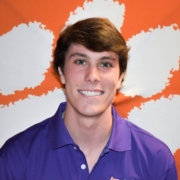
Ty Williams
/in Student Alumni CouncilName: Ty Williams
Hometown: Cumming, GA
Major: Biosystems Engineering
Favorite SAC event: Welcome Back Festival
Why this is your favorite event: Welcome back festival is the perfect way to excite students to be back at school for the fall semester and to welcome the new incoming students with a fun, school-wide event. I love the environment of the festival and as a freshman I learned so much about the City of Clemson.
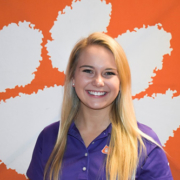
Ashlea Willis
/in Student Alumni CouncilName: Ashlea Willis
Hometown: Greenwood, SC
Major: Microbiology
Favorite SAC event: Ring Ceremony
Why this is your favorite event: I love the meaning behind the Clemson ring! I cry at every ceremony because it is an honor for every student to receive their ring and be able to say “I went to Clemson!”
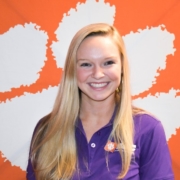
Caroline Cavendish
/in Student Alumni CouncilName: Caroline Cavendish
Hometown: Spartanburg, SC
Major: English
Favorite SAC event: Senior Week
Why this is your favorite event: I love this event because I love a good celebration and it’s a celebration that lasts a whole week!!! Senior Week celebrates the accomplishments of talented, intelligent, driven seniors who have given their all to Clemson for four years. I love being able to watch them have a good time before they walk across the stage in May.
Stewart Buxton
/in Student Alumni CouncilName: Stewart Buxton
Hometown: Columbia, SC
Major: Communications
Favorite SAC event: Master Teacher
Why this is your favorite event: This event celebrates what I believe a Clemson education should always represent. A teacher who makes a monumental impact on countless students gets the chance to see that they are deeply appreciated. I love the way this event shines a spotlight on those who often do not get enough thanks!
Scroll of Honor – John Duncan McArthur, Jr.
/in Uncategorized“An All-Round-Fellow”
At least three Clemson men were on board the ship when it set sail from Southampton, England on the morning of Christmas Eve 1944. The ship was the Léopoldville, a Belgian transport that had made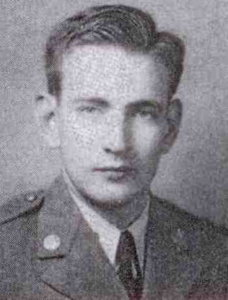 twenty-four Channel crossings and had already carried 120,000 Allied soldiers to France. On this particular voyage, Léopoldville was transporting two regiments of the American 66th Infantry Division plus a number of British soldiers. None of them would forget this Christmas Eve.
twenty-four Channel crossings and had already carried 120,000 Allied soldiers to France. On this particular voyage, Léopoldville was transporting two regiments of the American 66th Infantry Division plus a number of British soldiers. None of them would forget this Christmas Eve.
One of those on board Léopoldville as the last light faded from the winter sky was Second Lieutenant John Duncan McArthur, Jr. of Anderson, Clemson Class of 1944. McArthur and his division had arrived in England only a month earlier and were now being hurried to France to reinforce Allied lines in response to the Germans’ winter offensive that would come to be known as the Battle of the Bulge.
McArthur, son of Mr. and Mrs. John D. McArthur, Sr. of East River Street in Anderson, had graduated from Boys High School and enrolled in Clemson College in 1940. He had participated in extracurricular activities in high school and continued those pursuits on campus. A textile chemistry major, Johnny demonstrated leadership abilities early on. He was a member of Tiger Brotherhood, the Anderson County Club, the Pershing Rifles, the YMCA Cabinet and Phi Si, the textile honorary fraternity. He was also a member of the swimming team.
McArthur was assigned to Company D-2 in what was at the time the largest infantry ROTC cadet corps in the nation. By the time he began his junior year, Johnny was the cadet first sergeant of D-2. He would have expected to attend ROTC summer training at the end of the school year and then serve as  a cadet officer as a senior, but the War Department had other plans. By this time of course, the war was raging around the globe and Clemson men were serving in every theater. The demand for manpower—and especially for young leaders—was increasing rapidly as America continued the mobilization of manpower and industry. During the spring semester of 1943, the War Department announced that seniors would go directly into service following their graduations. McArthur and his classmates would forego their senior years on campus and go directly into basic training following the end of spring classes. Those showing aptitude would have the opportunity to advance to Officer Candidate School.
a cadet officer as a senior, but the War Department had other plans. By this time of course, the war was raging around the globe and Clemson men were serving in every theater. The demand for manpower—and especially for young leaders—was increasing rapidly as America continued the mobilization of manpower and industry. During the spring semester of 1943, the War Department announced that seniors would go directly into service following their graduations. McArthur and his classmates would forego their senior years on campus and go directly into basic training following the end of spring classes. Those showing aptitude would have the opportunity to advance to Officer Candidate School.
McArthur was, not surprisingly given his record as a cadet, one of those selected for officer training. He was sent to Fort Benning, Georgia for OCS and, following its successful completion, was commissioned a second lieutenant and assigned to the 66th Infantry Division, the Black Panthers, then training at Camp Rucker, Alabama. On the Sunday after Thanksgiving, November 26, 1944, McArthur’s regiment landed in Dorchester, England. Their pre-combat training was cut short by the Battle of the Bulge and the division was rushed to Southampton for its Christmas Eve crossing of the English Channel.
Léopoldville was just five miles from its destination, the French port of Cherbourg, when at 1754 hours, despite an escort composed of one French and three British warships, it was struck by a torpedo fired from a German U-boat. In the December darkness, Léopoldville began to sink. Neither the captain, who spoke Flemish, or his crew, most of whom came from the Belgian Congo, spoke English. Radio communications between ship and shore were also hampered by different frequencies. As a result, most of the men on board ended up in the frigid waters, struggling to survive until they could be rescued.
One of those in the water as the evening turned to night was Second Lieutenant McArthur. 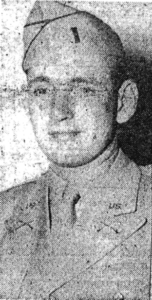 According to a newspaper report, McArthur, the Clemson swimming letterman, paddled among the survivors of the sinking ship helping those who were wounded or who could not swim. Seven hundred sixty-two men were killed, including Clemson alumni William Ingram Lawrence and James Lee Loftis both of the Class of 1946, in the sinking of Léopoldville making it the second deadliest troop ship disaster in the European war.
According to a newspaper report, McArthur, the Clemson swimming letterman, paddled among the survivors of the sinking ship helping those who were wounded or who could not swim. Seven hundred sixty-two men were killed, including Clemson alumni William Ingram Lawrence and James Lee Loftis both of the Class of 1946, in the sinking of Léopoldville making it the second deadliest troop ship disaster in the European war.
Once they finally reached French shores and, on December 29 relieved the 94th Infantry Division, McArthur and the 66th were assigned to destroy by-passed pockets of German troops still remaining in northern France. Over the next two months, the 66th conducted limited attacks to gather intelligence and reduce the pockets of German resisters. On February 20, 1945, just eleven weeks before V-E Day, McArthur was killed in Germany.
McArthur was survived by his parents and two sisters. He is interred at Brittany American Cemetery, St. James, France. In reporting the death of one of the city’s sons, the Anderson Independent wrote “He was held in high esteem by all who knew him. Johnny was known as an all-round fellow and he will be missed by all who were fortunate in claiming him as a friend.”
For more information on John Duncan McArthur, Jr. see:
https://soh.alumni.clemson.edu/scroll/john-duncan-mcarthur-jr/
For additional information on Clemson University’s Scroll of Honor visit:
Clemson Legends Party at the National Championship
/in Uncategorized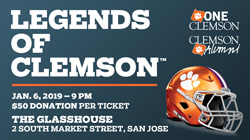
Join us for the ONE Clemson Legends Party 2019 before the National Championship! Doors will open at 9:00pm. Guests will be greeted with a red carpet reception on which Clemson fans and alumni will have the opportunity to have their picture taken with Clemson Legends!
Where: The Glasshouse
2 South Market Street
San Jose, CA
Here are some of the Legends you will meet:
Patrick Sapp
Brentson Buckner
Tajh Boyd
Dexter McCleon
Andre Branch
CJ Spiller
Kris Benson
Lou Richie
Jim Bundren
Jacoby Ford
Grady Jarrett
Chansi Stuckey
Vic Beasley
Jock Mckissic
Mackensie Alexander
Jarvis Jenkins
Mike Williams
Marcus Edmonds
Scroll of Honor – James Goldsmith
/in UncategorizedGerm Warfare
The biggest killer in 1918 wasn’t the Great War, as the First World War was known at the time. 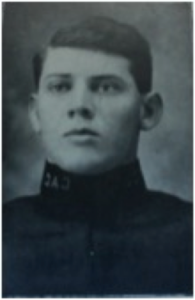 In fact, the war, with all of its attending miseries, was a distant second—a very distant second.
In fact, the war, with all of its attending miseries, was a distant second—a very distant second.
James Goldsmith was a Greenville boy who enrolled at Clemson College as a member of the Class of 1914. Goldsmith and his fellow cadets lived in the original barracks lined up behind the Main Building and its clock tower. Johnstone, Lever, Tillman, Donaldson, Wannamaker, Bradley and Manning were the College’s life trustees. The youthful Walter Merritt Riggs was the College president and taught a Bible class, as did English professor D. W. Daniel. We don’t know much about Goldsmith’s campus experience, but we do know that by 1918, he had enlisted in the Army and was training at the officer training school at Camp Hancock in Augusta, Georgia.
Before Goldsmith could complete his training, the war ended with the November 11 armistice and the doughboys began returning home—but they were not alone.
An outbreak of influenza had occurred in the spring of that year. It was first identified at Army posts around the country. The movements of large formations of soldiers across the country and across the sea helped spread the flu virus, but it was a second, more virulent wave of the disease that struck the hardest. The first outbreaks were noted in September, in Boston, where shipments of men and war supplies kept the harbor full of traffic. Soldiers, sailors and merchant seamen packed into the tight confines of ships carried the flu germs into the city and to wherever their cargo was bound. Within weeks, the illness was spreading across the United States and with devastating effect.
It was often referred to as the Spanish Flu, but its origins in Spain are doubtful. Spain, a neutral in the war, had no press censorship and so cases of the flu—including the illness of the King—were widely reported. The United States, Great Britain, France and Germany, as belligerents, suppressed reports of the growing pandemic due to fears of the effect such news would have on the morale of peoples at war.
In October, more than 200,000 Americans died from the flu. The end of the war on November 11 led to widespread celebrations—parades, parties, worship services—that brought thousands of people into close proximity creating ideal conditions for the disease to spread. In stark contrast to earlier strains of the flu, the segment of the population hardest hit was those between the ages of 24 and 35 years of age. Researches hypothesized that the flu triggered an overreaction of the body’s immune system. Ironically, the stronger defensive reactions of young adults ravaged their bodies. The weaker immune systems of children and middle-aged adults resulted in fewer deaths.
The pandemic, which would rage across the globe into 1919, killed between twenty and forty million, far 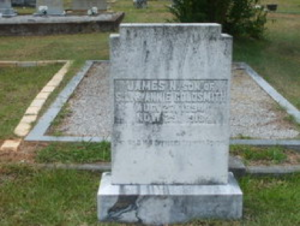 more even than the infamous Black Death Bubonic Plague of the mid-1300s. Twenty-eight percent of Americans fell ill and 675,000 died, including James Goldsmith.
more even than the infamous Black Death Bubonic Plague of the mid-1300s. Twenty-eight percent of Americans fell ill and 675,000 died, including James Goldsmith.
Goldsmith, who just eighteen months earlier had wed, died on November 29, less than three weeks after the end of the War to End All Wars. He is buried at Rose Hill Cemetery in Piedmont.
The effect of the influenza epidemic of 1918-19 was so severe that it dropped the average life span in the United States by ten years.
For more information on James Goldsmith see:
For additional information on Clemson University’s Scroll of Honor visit:
Scroll of Honor – Francis Stafford Barnes, Jr.
/in UncategorizedSon of Two Institutions
In the spring of 1944, as Europe was holding its breath in anticipation of the long-awaited Allied Invasion,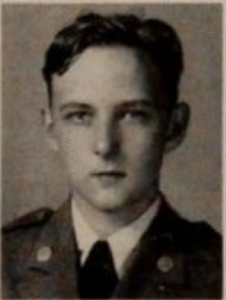 an invasion of smaller scale was taking shape in the southwest Pacific. General Douglas MacArthur, seeking to make good on his pledge to return to the Philippines, had his eyes on Biak Island. Biak dominated the entrance to Geelvink Bay at the western end of New Guinea and was some 850 miles north-northeast of Darwin, Australia. The island was garrisoned by 11,000 Japanese troops under the command of Colonel Kuzume Naoyuki.
an invasion of smaller scale was taking shape in the southwest Pacific. General Douglas MacArthur, seeking to make good on his pledge to return to the Philippines, had his eyes on Biak Island. Biak dominated the entrance to Geelvink Bay at the western end of New Guinea and was some 850 miles north-northeast of Darwin, Australia. The island was garrisoned by 11,000 Japanese troops under the command of Colonel Kuzume Naoyuki.
New Guinea had been in the news since shortly after Pearl Harbor. In January 1942, the Japanese had attacked and captured Australian-administered territory in eastern New Guinea. In March, the Japanese overran the western portion of the island which had been part of the Netherlands East Indies. By the time Frank Barnes, Jr. graduated with the Class of 1942, he likely would have been familiar with this jungle island on the other side of the world. Before he completed his Army training, US forces would be locked in a death struggle with Japanese defenders in eastern New Guinea.
Francis Stafford Barnes, Jr. of Greenville enrolled at Clemson College in 1938 to study architecture. He attended Clemson only for his freshman year, then transferred to the University of South Carolina. At USC, he excelled academically, graduating as a member of Phi Beta Kappa.
With the country at war, Frank Barnes headed to Fort Benning, Georgia for infantry officer training. 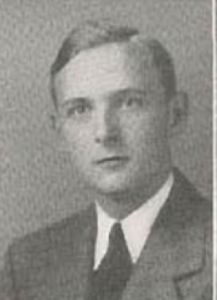 He was next assigned to Camp Blanding, Florida and then Camp Roberts, California. In late 1943, he shipped overseas. By the spring of 1944, Barnes was assigned to K Company of the 162nd Infantry Regiment, 41st Infantry Division.
He was next assigned to Camp Blanding, Florida and then Camp Roberts, California. In late 1943, he shipped overseas. By the spring of 1944, Barnes was assigned to K Company of the 162nd Infantry Regiment, 41st Infantry Division.
D-Day for the Biak invasion was May 27, 1944. At 0900, American forces began landing on the island. A tank battle developed between Japanese Ha Go Type 95 machines with their 37 mm canons and US Sherman tanks mounting a larger 75 mm gun. Following the tanks, infantrymen of K Company targeted their Japanese counterparts. During the battle, K Company was forced at one point to yield ground it had already fought over. K Company soldier Charles Brockman recalled that a daring six-man patrol led by Tech Sergeant Rex Smith made its way some 200 yards back into ground the company had given up during the attack. Smith and his men recovered weapons, equipment and the body of Second Lieutenant Barnes.
Brockman remembered that K Company “probably had our longest casualty list of World War II” that day. Seven members of the company were killed and twenty-one were wounded.
Second Lieutenant Francis Stafford Barnes, Jr. was posthumously awarded the Purple Heart. He was survived by his parents, Mr. and Mrs. Francis S. Barnes of Greenville.
Frank Barnes was an alumnus of both Clemson and Carolina and an American hero. He is poignant example of the ties that bind us together.
For more information about Francis Stafford Barnes, Jr. see:
For additional information about Clemson’s Scroll of Honor, visit:
Scroll of Honor – Forrest Hugh Coleman, Jr.
/in UncategorizedToo Young to be Old
To most of us, 33 doesn’t seem very old. But, when you’re surrounded by young men in their late teens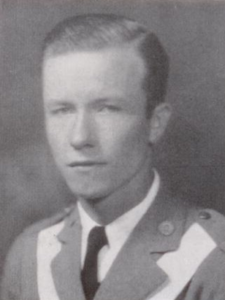 and early 20s, your perspective might change a bit. Forrest Hugh Coleman, Jr. of Laurens found himself in just this situation when he was called to active duty in November 1942.
and early 20s, your perspective might change a bit. Forrest Hugh Coleman, Jr. of Laurens found himself in just this situation when he was called to active duty in November 1942.
Coleman enrolled in Clemson College just as the Great Depression began to squeeze the momentum from the United States economy. A member of the Class of 1933, Coleman was selected as the Best Drilled Cadet during his sophomore year of 1930. Coleman was an electrical engineering major and served as vice president of the Laurens County Club, was a member of the Sabre Club and attended ROTC training at Fort McClellan, Alabama.
Coleman married the former Caroline Burroughs of Augusta, Georgia. They were the parents of a daughter, Sue, and son, Forrest Hugh III.
In October 1940, the United States implemented its first peace-time draft. Draftees were called to federal service for a twelve month term to undergo basic military training. Fearful of the international situation, President Roosevelt in the summer of 1941 asked Congress to extend the draftees’ tours of duty beyond twelve months. After the United States entered World War II, a new Selective Service Act made men between 18 and 45 eligible for military service and required all men between the ages of 18 and 65 to register.
By April 1942, the Army was inducting young men at the rate of almost 150,000 a month. The supply of 1-A men, those deemed “available for military service,” from the 1940 registration was running out. Local draft boards began eying slightly older registrants. Coleman, when called to duty in November, had already passed his 33rd birthday, making him senior to most of the men with whom he would soon be serving.
Coleman was assigned to the 3rd Infantry Division which in August of 1944, two months after the D-Day invasion in Normandy, would land across the beaches of southern France as part of General Alexander Patch’s 7th Army. By September 11, 7th Army had linked up with Patton’s 3rd Army, and it seemed as if the war was nearly over. The 3rd Infantry Division reached the Rhine River on November 26, but was ordered to dig in and hold the position due to logistical restraints. Having reached the very border of Hitler’s Third Reich, Coleman was killed in action three days later.
First Lieutenant Coleman was survived by his wife, two children and his sister. In 1948, his body was returned to the United States. He was interred at Westview Memorial Park in Laurens. He is also memorialized on the Laurens War Memorial.
For additional information about Forrest Hugh Coleman, Jr. see:
https://soh.alumni.clemson.edu/scroll/forrest-hugh-coleman-jr/
For more information about Clemson University’s Scroll of Honor visit:
https://soh.alumni.clemson.edu/scroll-of-honor/
Scroll of Honor – Robert Vines Bruce
/in UncategorizedA Victory of Sorts
Robert Vines Bruce attended Clemson College during the 1941-42 academic year, having already graduated from Boys’ High School and Anderson College in his hometown of Anderson. He was pursuing a pre-medicine course of study, intending to follow in the footsteps of his father, older brother and sister, each of whom was a doctor.
Bruce was called to active duty in March 1942 and was commissioned after Air Corps training. Bruce completed bombardier training and, in August 1943, shipped overseas. He was assigned to the 427th Bomb Squadron of the 303rd Bomb Group stationed at Molesworth, England.
The 303rd had arrived at Molesworth in Cambridgeshire north of London in November of the previous year, while Bruce was still in training. Beginning that month, the Group would go on to fly 364 missions, more than any other Eighth Air Force B-17 Group during World War II.
Bruce arrived in England during a period in which historian Donald Miller writes “casualties began to rise alarmingly.” The Eighth Air Force’s losses meant that newly arriving airmen and aircraft were being used “as replacements for decimated groups” rather than forming the basis of new combat formations.1
On October 9, 1943, Bruce’s crew, led by pilot Second Lieutenant Bernard Clifford, was alerted for a mission deep into Germany. On what was a busy day for the Eighth Air Force at that point in the war, 378 heavy bombers were dispatched to bomb four targets, two in Germany and two in Poland. Bruce’s aircraft was part of a one hundred fifteen
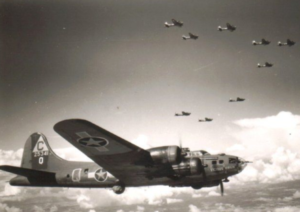
A B-17 of the 303rd Bomb Group in formation
plane force targeting the Arado Flugzeugwerke at Anklam on Germany’s Baltic Sea coast. The factory produced wings and tail sections for Germany’s FW-190 fighters, the very aircraft that would soon figure so prominently in the fate of Bruce and his crew.
The bomber crews were awakened in time to breakfast at 0320 hours. The early start was necessary to be able to make the 1,190 nautical mile trip during the daylight hours of the shortening autumn day. The 303rd was the lead group flying at a relatively low formation of 13,000 feet. It was the fourth combat mission for Bruce and the rest of the crew.
The heavy bombers delivered their payloads, dropping high explosive and incendiary bombs on the aircraft factory and then turned back toward England.
Around midday, Bruce’s aircraft was attacked by three FW-190 fighters flying three abreast. Rounds from the fighters’ 20 mm cannons hit the B-17, nicknamed “Son.” With its number three engine on fire and its propeller feathered, “Son” lost contact with the bomber formation at an altitude of 8,000 feet. It had lowered its landing gear, a signal to its attackers that it was no longer able to fight. At this sign, the German fighters withdrew.
But, the damage was done. The big bomber sank lower and lower, the frigid waters of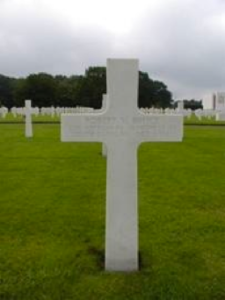 the Baltic Sea coming closer and closer. The B-17 crashed into the sea at approximately 1220 hours near Lolland, Denmark. All ten members of the crew were killed.
the Baltic Sea coming closer and closer. The B-17 crashed into the sea at approximately 1220 hours near Lolland, Denmark. All ten members of the crew were killed.
Over a month later, on November 13, Bruce’s body was found on the beach at Dazendorfer Strand in Holstein, Germany. He was laid to rest in Heiligenhafen Cemetery two days later. After the war, Bruce’s remains were reinterred in the Ardennes American Cemetery in Neupre, Belgium. Bruce was awarded the Purple Heart. He was survived by his mother, his brother and six sisters.
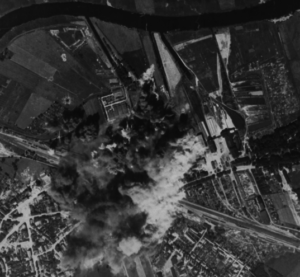
Strike photos hint at the devastation afflicted at Anklam
The Arado plant and approximately 80% of the surrounding town were destroyed. As a result, fabrication of parts for Focke-Wulf, Junkers and Messerschmitt aircraft were dispersed to other areas. The mission for which Robert Vines Bruce and the other nine members of his crew had given their lives was considered a victory.
For more information about Second Lieutenant Robert Vines Bruce see:
https://cualumni.clemson.edu/page.aspx?pid=1818
For additional information on Clemson University’s Scroll of Honor visit: https://soh.alumni.clemson.edu/scroll-of-honor/
- Donald L. Miller, Masters of the Air: America’s Bomber Boys Who Fought The Air War Against Nazi Germany, (New York: Simon & Schuster Paperbacks, 2006), 167.
Distinguished Service Award Nomination Form
/in UncategorizedNOTE: The details provided in the nomination form and the support letters are the sole source of information that the committee uses in the evaluation and selection of candidates. Please take this into consideration when determining the extent to which you complete the questions below.
Clemson Alumni Association Social Media Promotion Policy
/in Marketing Resources, Toolkit, UncategorizedThe Clemson Alumni Association prides itself on enhancing the lifelong Clemson experience by serving, involving, informing, and engaging our alumni, current and future students, and friends of the University. Our social media accounts have been implemented to achieve these goals. Promoting content that exhibits a strong relationship with the Alumni Association is just one of the many ways we attempt to fulfill our mission. Therefore, the Alumni Association is open to promoting certain events and material that are not hosted solely by the Clemson Alumni Association, but by officially approved extensions of the Alumni Association.
Below are the approved guidelines for content that will, and will not be promoted by the Alumni Association on the official Alumni social media websites. The criteria for content that will be considered for promotion is also included.
Content that will be promoted by the Clemson Alumni Association
- Events that exhibit a strong relationship with/support the Clemson Alumni Association
- Content that exhibits a strong relationship with/supports the Clemson Alumni Association
- Fundraisers that exhibit a strong relationship with/support the Clemson Alumni Association
Definition of content that has a strong relationship with the Clemson Alumni Association:
- The content is sponsored by the Clemson Alumni Association
- The content is sponsored by the University
- The content benefits the Clemson Alumni Association, alumni, and students all together
- The Content contributes to the mission of the Clemson Alumni Association
- If the content is an event:
- The majority of those who organize/host the event are alumni
- The majority of those participating are alumni/students
- The event benefits a large amount of alumni
- Proceeds of the event benefit Clemson University, the Alumni Association, the university campaign and/or an officially charted entity of the Alumni Association
- The content targets the Clemson Alumni Association’s preferred audiences
- The content networks current students/young alumni with older/current alumni
- The content provides alumni with opportunities to give back to Clemson University
- The content that is deemed to be a feature story by our discretion
Club and Group Network Initiatives and Student Clubs and Organizations
- The Alumni Association will not post content promoting initiatives by Clemson Clubs and Special Interest Groups due to the vast number of entities that fall within this categorization. However, clubs and groups are encouraged to tag Alumni Association social media accounts in posting their events.
- In the same vein, the Alumni Association will not promote the initiatives of the various student groups and organizations on campus but will promote initiatives produce by Student Affairs. However, student groups and organizations are encouraged to tag Alumni Association social media accounts in posting their events.
Content that will not be promoted by the Clemson Alumni Association
- Selling of any goods or services that are not sold specifically by the Alumni Association or its contractual partners
- Does not have a strong/contractual relationship with the Clemson Alumni Association
- Content that involves:
- Illegal activity
- Hate speech
- Harassment
- Minors
- Sex/nudity
- Shock value
- Events that are:
- Unsafe
- Deceptive/misleading
- Not compatible with the missions and values of the Clemson Alumni Association
- Political campaigns
- Spam
- Content that is asking to share a post for a contest
- Content that involves court cases
Guidelines for submitting content to be promoted
- Must be submitted within 2 weeks of desired date of promotion
- Must fill out application
- Event application
- Fundraiser application
- Material application
Ricoh Print Services for Clubs and Groups
/in Marketing Resources, Toolkit, UncategorizedIn celebration of Clemson, our on-campus print and mail center would like to extend their services to the Clemson Clubs and Clemson affiliates at the same discounted rates offered to employees which average 20% below commercial retail costs. In addition to these low rates, turnaround times are typically within a few days and can include a free proof sent to you. The on-campus print and mail center uses negotiated UPS & FedEx rates so shipping costs are far lower than standard costs.
Services available include high quality color and black & white printing, copying, a complete bindery, fulfillment and bulk mailing services. Start saving money on your printing and mailing projects and take advantage of this opportunity.
To learn more or get a free quote, please contact Shannell Yvonne Mathis at shannem@clemson.edu or 864-656-0687.
2018 Nashville Prowl & Growl Photo Submission Form
/in UncategorizedProwl & Growl photos are now available. Please complete the form below to download your photo. Thank you for attending and Go Tigers!
Nashville Prowl & Growl Photo Form
This form allows the individual submitting the form access to photos from the Nashville Prowl & Growl
Emma Interest Form
/in UncategorizedEmma Interest Form
This for is intended to determine interest in and gather specific details pertaining to additional accounts in MyEmma.
Clemson Alumni Association Officer Nomination Information
/in UncategorizedThe Officers of the Clemson Alumni Association are the President, President-Elect, and Immediate Past President. Each of these capacities carries with it a two-year term that commences on July 1, following the election of a President-Elect. As such, the cumulative commitment of service for an Officer is six years, from the commencement of duties as President-Elect to the completion of a term as Immediate Past President.
The duties of the officers of the Alumni Association are generally as follows:
- President–The President is the presiding officer and chief ambassador of the Alumni Association, and serves as Chair for all meetings of the Association, Council, Board of Directors, and Executive Committee; appoints the standing committees and any special committees deemed appropriate; serves as a member of the Clemson Foundation Board; serves as a member of the IPTAY Board of Directors; appoints the Alumni Association’s representative to the Athletic Council; appoints at-large representatives to the Alumni Council; serves as an ex-officio member of all committees and each Clemson Club and Alumni Constituency group; performs all duties and responsibilities generally assigned to the office of President.
- President-Elect–The President-Elect shall, in the absence or at the request of the President, carry out the duties of the President; serves as Chair of the Honors and Awards Committee; serves as a member of the Clemson Foundation Board.
- Immediate Past President–The Immediate Past President shall serve in whatever capacity is deemed appropriate by the President, and serves as the Chair of the Nominating Committee.
While each of these leadership positions consists of responsibilities critical to the success of the Association, it should come as no surprise that the role of President is chief in terms of importance and time commitment. It is estimated that this individual will – on average – spend 10 hours/week engaged in official Alumni Association business and initiatives. Some weeks could require up to 20 or more hours of a time commitment, especially during the scheduled meetings of the various University leadership boards (Alumni Association, Foundation, and IPTAY). The ability to travel regularly to campus, as well as to attend other Association events off-campus, is required of the President.
It is equally important to note that the role of Officer is a volunteer position. Travel expenditures, as well as lodging and related accommodations, for Association-related activities are the responsibility of the Officer.
An interest/nomination form is can be found by clicking here. This form should be used to submit the name and supporting information for any candidate. All nominations must be received by close of business on April 12, 2024. For best consideration, candidates should submit up to three accompanying letters of support. Letters can be attached to the form via the supporting documents field.
Each nomination will be forwarded to the Nominating Committee, to be reviewed and screened by its membership. The Nominating Committee will present its recommendations of qualified candidates to the Alumni Board of Directors, and the election of new Directors will take place during the Board of Directors meeting in the Spring in Clemson.
For more information on the duties and responsibilities of a Director of the Alumni Association Board, or for general inquiries on the nominations and selection process, please contact Wil Brasington, wil@clemson.edu.
Clemson Alumni Association Board Nominations Guidelines
/in UncategorizedPer the Alumni Association Constitution, the Board “is responsible for overall policy, direction, and organizational vision of the Alumni Association”. As such, each of its members shall have at least the following duties and responsibilities:
a) oversight of the financial and administrative affairs of the Alumni Association
b) establishment of policies and goals to fulfill the mission and purpose of the Association
c) deliberation and decision upon any proposed contractual relationship or partnership between
the Association and any outside party
d) report to the Council at each meeting and as requested
A full term of service to the Board is three years, and the Board meets no fewer than four times annually to conduct its business.
Candidates are sought who meet the following qualifications: a) sound judgment, b) strong work ethic, c) demonstrated service to the University and Alumni Association, d) leadership qualities and potential, and e) the desire and vision to advance the goals and objectives of the Association.
Through its nominations process, the Clemson Alumni Association seeks qualified individuals to serve on its Board of Directors while also achieving a board composition that is representative of the constituency it serves. Only those who have graduated from Clemson (alumni) and those who have been designated Honorary Alumni are eligible to serve on the board.
An interest/nomination form is can be found by clicking here. This form should be used to submit the name and supporting information for any candidate. Self-nominations will be accepted, but the opportunity exists for a candidate to be nominated or endorsed by one or more from a third party. All nominations must be received by close of business on April 12, 2024. Candidates must submit no less than one, and up to three accompanying letters of support. Each candidate must also have a member currently seated on the Clemson Alumni Association Board of Directors as their nomination sponsor. Letters can be attached to the form via the supporting documents field.
Each nomination will be forwarded to the Nominating Committee, to be reviewed and screened by its membership. The Nominating Committee will present its recommendations of qualified candidates to the Alumni Board of Directors, and the election of new Directors will take place during the Clemson Alumni Board of Directors meeting in the Spring in Clemson.
For more information on the duties and responsibilities of a Director of the Alumni Association Board, or for general inquiries on the nominations and selection process, please contact Wil Brasington, wil@clemson.edu.
Clemson Family Goodyear Cotton Bowl Events
/in Uncategorized
The Clemson Tigers are going to the Goodyear Cotton Bowl! Join us in Texas for an orange-filled weekend full of events, food, freebies and cheering on the Tigers!
Friday, December 28, 2018
Make a Difference in Dallas – Clemson Family Service Project
8:30 – 11:30 am
Team up with Clemson faculty, staff and other volunteers to make a difference in Dallas!
As the Clemson Tigers prepare to face Notre Dame in the Goodyear Cotton Bowl Classic, the Clemson Alumni Association and Clemson University Student Affairs are teaming up with Goodwill Industries of Dallas to perform tasks like sorting donations, unloading trucks, working in the repair shop and preparing care packages. Registration is required to participate. Space is limited, so please register early! Register ➡️http://bit.ly/clemsoncottonservice. While we are in town to celebrate Clemson, help us make a positive impact in Dallas and show the world Every Tiger Cares!
Clemson Family – Welcome to Texas Event
5:00 – 7:00 pm
Lets turn Texas Clemson Orange before the College Football Playoff Goodyear Cotton Bowl! Join the  Clemson Family, Clemson Alumni Association, IPTAY and the Dallas/Ft Worth Clemson Club at Sports & Social located at Texas Live! starting at 5:00 pm (1650 E Randol Mill Rd, Arlington, Texas 76011) after the Battle of the Bands. This is a FREE, family-friendly event.
Clemson Family, Clemson Alumni Association, IPTAY and the Dallas/Ft Worth Clemson Club at Sports & Social located at Texas Live! starting at 5:00 pm (1650 E Randol Mill Rd, Arlington, Texas 76011) after the Battle of the Bands. This is a FREE, family-friendly event.
Sports & Social will have a full menu available, however if you want to skip the wait, take advantage of the tailgate-style buffet! You can pre-purchase buffet tickets or buy them at the door. Click Here to purchase one of three tailgate-style buffet tickets through Sports & Social.
Saturday, December 29, 2018
Clemson Family Tailgate @ the AT&T Stadium, Arlington, TX (home of the Dallas Cowboys) is SOLD OUT
11:30 am – 2:00 pm (CST)
Join the Clemson Alumni Association and IPTAY for a pre-game tailgate inside AT&T Stadium – home of the Dallas Cowboys.
We all know the Clemson Family enjoys the pregame celebration, and it’s time for one of the biggest tailgates of the year. Join the Clemson Alumni Association and IPTAY prior to the Goodyear Cotton Bowl on Saturday, December 29th for the Clemson Family Tailgate.
- The tailgate will be located inside AT&T Stadium and will run from 11:30 a.m. – 2:00 p.m. (CST)
- Tickets are $85 per person for adults
- Tickets for children 12 and under are $45
- Ticket includes a BBQ menu consisting of BBQ spiced kettle chips and jalapeno onion dip, blue corn chips and salsa, Texas chopped salad with chipotle-agave vinaigrette and BBQ ranch, Cowboys caviar, build your own BBQ slider bar with chopped brisket, pulled pork, pickles, jalapenos, bourbon BBQ sauce, tumbleweed onions, mac n cheese with popcorn chicken, buffalo sauce and blue cheese crumbles, Clemson logo cookies and team colored cupcakes.
- An open bar with beer, wine and liquor is also included with the adult ticket.
- You must have a game ticket and tailgate ticket to enter and you must plan to remain inside the stadium once you have entered. Once you enter the tailgate and are inside the stadium, you will not be allowed to leave and re-enter the stadium.
- The tailgate will be inside AT&T Stadium spread across two levels connected by elevators and escalators.
- The tailgate is SOLD OUT
Tickets will be delivered via mobile delivery. There will be no hard copy tickets for the tailgate. Upon arrival, please enter through Gate G.
Dallas Travelers Events – Thursday through Saturday
For those who plan to stay in Dallas for the Cotton Bowl and are looking for a place to gather in the Dallas 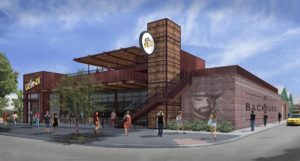 area, celebrate the Tigers at Bottled Blonde and Backyard. Starting Thursday evening, December 27th, through Saturday, December 29th, both venues will give a portion of their proceeds back to the Dallas/Ft. Worth Clemson Club and ONE Clemson, the official Clemson Alumni Association affinity group focused on assisting student-athletes with their transition from college to career.
area, celebrate the Tigers at Bottled Blonde and Backyard. Starting Thursday evening, December 27th, through Saturday, December 29th, both venues will give a portion of their proceeds back to the Dallas/Ft. Worth Clemson Club and ONE Clemson, the official Clemson Alumni Association affinity group focused on assisting student-athletes with their transition from college to career.
Goodyear Cotton Bowl
Check out all of the details about fan activities at the official College Football Playoff Cotton Bowl site.
Clear Bag Policy in Effect – be mindful that it may take more time than usual to enter the stadium due to the clear bag policy so consider heading into the stadium early. Review all venue policies here.
Class of 1960 Capital Projects Tour
/in UncategorizedPlease complete the form below to indicate whether or not you plan to participate in the Class of 1960 Capital Projects Campus tour on Friday, June 9th during the Golden Tiger Reunion at Clemson.
This form is to help us know how many people plan to participate in order to determine if we are able to host the tour. It is important that you complete this form by Friday, May 19th so that we can secure transportation for the tour. Thank you for your assistance.
Class of 1960 Capital Projects Tour
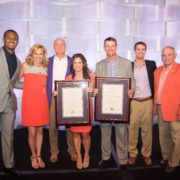
Swinneys Named Honorary Alumni
/in Honorary Alumni, UncategorizedWilliam Christopher “Dabo” Swinney and Kathleen Bennett Swinney have been named honorary alumni of Clemson University. Both were recognized with this designation at the 2017 All In Ball, an event presented by Dabo’s ALL IN TEAM FOUNDATION.
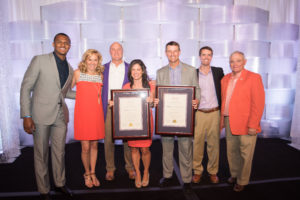
Left to Right: Deshaun Watson, Beth Clements, Clemson University President Jim Clements, Kathleen Swinney, Dabo Swinney, Clemson Alumni Executive Director Wil Brasington, Clemson Alumni President Sandy Edge
A graduate of the University of Alabama, Dabo began his career on the Clemson University Football Coaching Staff in 2003 and was named Interim Head Coach in 2008, eventually taking on the role permanently at the end of that football season.
Known for his exemplary recruitment of talented football players and enhancing the focus on student-athlete success in the classroom, Dabo recently lead the Clemson Tigers to become the 2016 National Football Champions.
Kathleen, also a graduate of the University of Alabama and former school teacher, has not only been a support system for Dabo and her family, but has also focused her attention on using her high-profile platform as the First Lady of Clemson Football to better the lives of others.
Dabo and Kathleen are highly recognized for their impact in the community including the development of Dabo’s ALL IN TEAM FOUNDATION. The mission of this organization is “to raise awareness of critical education and health issues in order to change lives of people across the state of South Carolina.”
The Foundation raises funds for various initiatives through three major events including the All In Ball, the Dabo Swinney Ladies Football Clinic and the Dabo Swinney Football Camp focused on elementary, middle and high school athletes.
The funds raised at these events are distributed to four primary focus entities including Breast Cancer Research, Call Me MISTER, The Family Effect and LIFE Programs at the University of Alabama and Clemson University which provide specific programming for children and young adults with learning disabilities and special learning needs.
In addition the foundation provides grants to organizations throughout the Upstate with similar objectives.
The Clemson Alumni Association president, Col. Sandy Edge, and Executive Director, Wil Brasington, along with University President James P. Clements and his wife Beth, presented the Swinneys with the honor.
Honorary alumni are selected by the Alumni Association Honors and Awards Committee on the basis of outstanding service, lifelong devotion and loyalty to Clemson University or the Clemson Alumni Association. To see past honorary alumni or to view the award guidelines, visit the honorary alumni web page.
END
The Clemson Alumni Association is an open-membership, nonprofit organization. Since its inception in 1896, the program has connected members of the Clemson Family, inspiring pride, celebrating achievement, providing service and strengthening relationships.
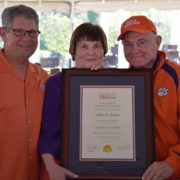
Mickey Harder Named Honorary Alumna of Clemson University
/in Honorary Alumni, UncategorizedLillian U. “Mickey” Harder has been named an honorary alumna of Clemson University.
A South Carolina native, Harder holds degrees from Coker College and Converse College and has continued her studies at Boston University, the University of Georgia, Amherst College and the American Conservatory at Fontainebleau, France.
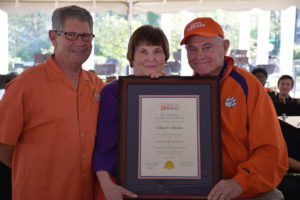
Clemson Alumni Association Past President, Danny Gregg (Left) and current President, Sandy Edge (Right), presented Mickey (Center) with the honor in front of her family and friends.
Harder came to Clemson with her husband in 1972 when he accepted the position as team physician for Clemson Athletics. Since this time, she has tirelessly devoted her time to nurturing performing arts at the University.
In 1986, Harder and her husband, Dr. Byron Harder, established an endowment to create the Lilian and Robert Utsey Chamber Music Series at Clemson University, the only endowed chamber music series of its kind in South Carolina.
In 1996, Harder became the Director of the Brooks Center for Performing Arts where she continues her career today. She has used this opportunity to provide the ability for Clemson students and local arts patrons to experience countless performances.
A member of the music faculty at Clemson prior to directing the Brooks Center, Harder taught piano lessons and music theory since 1972 when music was only offered as an elective. She provided classical music training to students as well as the tools succeed as musicians long after graduation.
Harder has previously received the Clemson Outstanding Faculty Woman Award given by the President’s Commission on the Status of Women, the Thomas Green Clemson Award and the Elizabeth O’Neil Verner Governor’s Award for the Arts.
Harder plans to retire later in 2017 but hopes to continue to program the concerts in the Utsey Chamber Music Series and provide support for the performing arts faculty and administration at Clemson.
The Clemson Alumni Association president, Col. Sandy Edge, and Past President, Danny Gregg, presented Harder with the honor in front of her family and friends.
Honorary alumni are selected by the Alumni Association Honors and Awards Committee on the basis of outstanding service, lifelong devotion and loyalty to Clemson University or the Clemson Alumni Association. To see past honorary alumni or to view the award guidelines, visit the honorary alumni web page.
END
The Clemson Alumni Association is an open-membership, nonprofit organization. Since its inception in 1896, the program has connected members of the Clemson Family, inspiring pride, celebrating achievement, providing service and strengthening relationships.
2017 Triangle Area Prowl & Growl Photo Submission Form
/in UncategorizedProwl & Growl photos are now available. Please complete the form below and you will be directed to the photos. Thank you for attending and Go Tigers!
Triangle Area Prowl & Growl Photo Form
This form allows the individual submitting the form access to photos from the Greenville Prowl & Growl
Adding an Event to the Alumni Event Calendar
/in UncategorizedQ: How do I get my event on the Clemson Alumni Event calendar?
A: All events submitted to the Alumni Association through the Info Request Form requesting an email be sent to a particular constituency base are automatically added to the Alumni Event Calendar and on the Clemson Club or Special Interest Group web page provide by the Alumni Association.
Click here to submit an email distribution request and to have your event added to the Alumni Association Event Calendar.
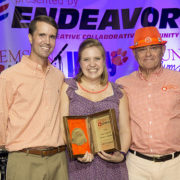
Clemson Alumni Association names Lily Eyraud of Charlotte its Volunteer of the Year
/in UncategorizedThe Clemson Alumni Association has selected Lily Eyraud of Charlotte to receive the 2016 Frank Kellers III Volunteer of the Year award. The award recognizes a Clemson alumnus for outstanding service and volunteerism to the university.
Eyraud previously served as chair of the engagement committee for the Clemson Young Alumni Council and currently serves as the communications lead for the Charlotte Clemson Club. For two years, she served as the Charlotte Clemson Young Alumni Council representative. Eyraud was also named to Clemson’s Young Alumni Council’s Roaring 10 this year for her continued efforts to uphold the university’s core values of honesty, integrity and respect.
Eyraud also serves the Charlotte community as a member of the United Way of Central Carolinas Young Leaders board since 2013. She has mentored and developed leaders as the regional recruitment coordinator for Gamma Phi Beta Sorority, and she was previously president of the sorority’s Charlotte alumnae chapter and education adviser for the Zeta Sigma chapter at the University of South Carolina.
Eyraud graduated from Clemson University in 2012 with a Bachelor of Science in financial management and a minor in accounting. A Certified Financial Planner, she is currently pursuing a Master of Business Administration through the Cross Continent Program at Duke University. Eyraud works as a retirement financial planner at TIAA-CREF, where she analyzes client finances up to $4 million in net worth. She also coordinates with TIAA-CREF’s director of community relations to enhance the company’s impact on the community through the United Way.
The Clemson Alumni Association has presented the Frank Kellers III Volunteer of the Year Award annually since 1988 to show recognition and appreciation to individuals who have a passion for service and building the Clemson family. The award is named for Frank Kellers III, a member of Clemson’s Class of 1957.
END
Clemson Alumni Association
The Clemson Alumni Association, an open-membership, nonprofit organization since its inception in 1896, connects members of the 140,000-strong Clemson family, inspiring pride, celebrating achievement, providing service and strengthening relationships with Clemson University and with each other.
Join Good Morning America at the National Championship
/in UncategorizedShow Your Clemson Spirit on Good Morning America in Tampa!
#ClemsonFamily!
Come be seen on national TV on January 9th, The morning of the National Championship Game! ABC’s Good Morning America 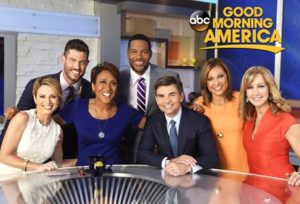 (@GMA) will broadcast live from Raymond James Stadium.
(@GMA) will broadcast live from Raymond James Stadium.
You will be able to be on the sideline and get some great shots inside the stadium! Come hang out with the @CU_Tiger and
Clemson University Cheerleading as well as the Good Morning America talent.
SIGN UP (FREE): https://1iota.com/Event/58163/Request
CONTACT: matthew.i.stone@abc.com with the names of those who would like to attend or reach him at 917-701-2749.
Please arrive at Raymond James Stadium in your #Clemson gear between 530-6AM with a photo ID!
Clemson National Championship Welcome Party
/in UncategorizedWelcome to Tampa Clemson Family!
Join Us Sunday, January 8th at 6:30pm
Downtown Tampa, FL is ready to be painted Clemson Orange!! The Clemson Alumni Association, IPTAY and the Florida Clemson clubs proudly invite all of our Clemson Family to the National Championship Clemson Welcome Party!
The host party location will be Yeoman’s Cask & Lion – 202 N. Morgan St, Tampa, FL 33602. Learn more about Yeoman’s at yeomanscaskandlion.com.
Situated just a few blocks from Amalie Arena, and a handful of blocks from Channelside and Curtis Hixon Park, this English themed restaurant and bar has the casual and fun atmosphere you will be looking for while you mingle with our fellow Clemson alumni, fans, and supporters! There will be drink specials for our Clemson Family.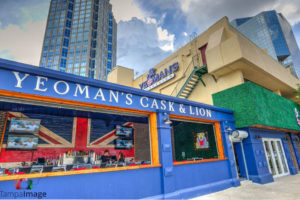
As the host location fills to capacity, we have alternate downtown restaurants and bars where our Tigers can meet up and mingle. Each location will have fellow Clemson Tigers representing the Florida Clemson Clubs to greet all of our Clemson Family! These locations will be open to our guests starting at 7p:
- Taps Wine and Beer Restaurant – 777 N Ashley Dr, Tampa, FL 33602
- Anise Global Gastropub (party starts at 8p) – next door to Taps at same address
- Pokeys – 100 E Madison St, Tampa, FL 33602
So wear your Orange and bring your Tiger $2 bills and join Clemson Alumni and the Florida Clemson clubs as we celebrate the Tigers!
Tigers Give Back at the Fiesta Bowl 2016
/in UncategorizedThe Tigers are playing the Ohio State Buckeyes at the Fiesta Bowl! But before the game we are joining together to pay forward packing boxes at St Mary’s Food Bank Alliance. Sign up to volunteer with fellow alumni, students, and more! Ohio State will also be there volunteering alongside us. We are looking for 75 volunteers and each individual person must register to participate.
Details:
Fri, December 30, 2016
8:30 am – 11:30 am
St Mary’s Food Bank Alliance
2831 N 31st Ave
Phoenix, AZ 85009
Map & Directions
Dress: Wear your Clemson spirit gear but dress in layers and bring a jacket or sweatshirt as the facilities are cold. Closed toe, closed heel shoes are required.
Agenda:
8:30am – volunteer check-in
9:00am – brief program and training
11:00am – service concludes and group photo taken
11:30am – depart
Parking: instructions to come
Homecoming Event Form
/in UncategorizedHomecoming Event Form
Charleston County Clemson Club Officer Nominations
/in UncategorizedThank you for participating in the Charleston County Clemson Club officer nominations! Please complete the information in the form below by Thursday, May 31st.
Charleston County Clemson Club-Officer Nominations
Thank you and Go Tigers!
Master of Real Estate Development Career Update Form
/in UncategorizedMRED Career Update
We look forward to connecting with you wherever you go and staying apprised of your current professional role. Let us know when you change positions so we can not only stay in touch, but also share with others the successes of our alumni.
Wisconsin Clemson Club Board Nominee Bio Form
/in UncategorizedThank you for your interest in serving on the Board of the Wisconsin Clemson Club! Please complete the information in the form below by Monday, June 27th.
Wisconsin Clemson Club Board Nominee Bio Form
Thank you and Go Tigers!
Philadelphia Clemson Club Board Nominee Bio Form
/in UncategorizedThank you for your interest in serving on the Board of the Philadelphia Clemson Club! Please complete the information in the form below by Monday, June 27th.
Philadelphia Clemson Club Board Nominee Bio Form
Thank you and Go Tigers!
New York/Tri-State Bio Form
/in UncategorizedThank you for your interest in serving on the Board of the New York/Tri-State Clemson Club! Please complete the information in the form below by Wednesday, June 22nd.
New York/Tri-State Bio Form
Thank you and Go Tigers!
College Restructuring Update
/in UncategorizedCollege Restructuring Update - RSVP
Class of 1949
/in UncategorizedRegistered Attendees of the 2016 Reunion
Class of 1949
| Hanks Jones | Julia Garmon |
Class of 1963
/in UncategorizedRegistered Attendees of the 2016 Golden Tiger Reunion
Member of the Class of 1963 |
Guest |
| Sara Ann Newton Ballentine |

